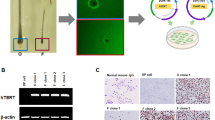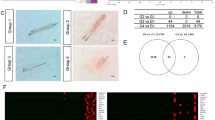Abstract
Female pattern hair loss (FPHL) is an important hair disorder, especially when young women are affected. However, pharmacological treatments are not successful in all women. Androgens, especially dihydrotestosterone (DHT), may play a role in FPHL, but many women with this disorder have normal serum androgen levels. It therefore appears that hair follicle levels of DHT depend on in situ testosterone (T) metabolism. Because T can be converted to DHT or estradiol (E2) by 5α-reductase (5α-R) and aromatase, respectively, these enzymes would determine DHT and E2 concentrations and their ratio. We propose and apply a low-invasive, sensitive and precise method for the absolute quantification of mRNA levels of aromatase and 5α-R isozymes (type 1, type 2 and type 3) in plucked hair from young women with FPHL. Normoandrogenic women with FPHL and controls were studied. Plucked hair samples were obtained by trichogram from vertex scalp and mRNA levels quantified by real-time RT-PCR. We revealed for the first time the presence of 5α-R3 mRNA in human hair. Interestingly, one, two, or even three 5α-R isozymes were increased in some women with FPHL but not in others, which may explain the lack of response to 5α-R inhibitors in some FPHL cases. Aromatase mRNA levels were significantly lower in women with FPHL than in controls. It may therefore produce a reduction in oestrogen levels and an increase in the androgen/oestrogen ratio in hair. The proposed low-invasive technique offers a molecular aetiologic diagnosis of FPHL for the selection of more appropriate pharmacological treatments with early predicted effectiveness.




Similar content being viewed by others
References
Atanaskova Mesinkovska N, Bergfeld WF (2013) Hair: what is new in diagnosis and management? Female pattern hair loss update: diagnosis and treatment. Dermatol Clin 31:119–127
Azzouni F, Godoy A, Li Y, Mohler J (2012) The 5 alpha-reductase isozyme family: a review of basic biology and their role in human diseases. Adv Urol 2012:530121
Bayne EK, Flanagan J, Einstein M, Ayala J, Chang B, Azzolina B, Whiting DA, Mumford RA, Thiboutot D, Singer II, Harris G (1999) Immunohistochemical localization of types 1 and 2 5alpha-reductase in human scalp. Br J Dermatol 141:481–491
Castro B, Sánchez P, Torres JM, Preda O, del Moral RG, Ortega E (2013) Bisphenol A exposure during adulthood alters expression of aromatase and 5α-reductase isozymes in rat prostate. PLoS One 8:e55905
Chen WC, Zouboulis CC (2009) Hormones and the pilosebaceous unit. Dermatoendocrinol 1:81–86
Cousen P, Messenger A (2010) Female pattern hair loss in complete androgen insensitivity syndrome. Br J Dermatol 162:1135–1137
Eicheler W, Happle R, Hoffmann R (1998) 5 alpha-reductase activity in the human hair follicle concentrates in the dermal papilla. Arch Dermatol Res 290:126–132
Eicheler W, Tuohimaa P, Vilja P, Adermann K, Forssmann WG, Aumüller G (1994) Immunocytochemical localization of human 5 alpha-reductase 2 with polyclonal antibodies in androgen target and non-target human tissues. J Histochem Cytochem 42:667–675
Ellis JA, Sinclair R, Harrap SB (2002) Androgenetic alopecia: pathogenesis and potential for therapy. Expert Rev Mol Med 4:1–11
Fronhoffs S, Totzke G, Stier S, Wernert N, Rothe M, Brüning T, Koch B, Sachinidis A, Vetter H, Ko Y (2002) A method for the rapid construction of cRNA standard curves in quantitative real-time reverse transcription polymerase chain reaction. Mol Cell Probes 16:99–110
Gerst C, Dalko M, Pichaud P, Galey JB, Buan B, Bernard BA (2002) Type-1 steroid 5 alpha-reductase is functionally active in the hair follicle as evidenced by new selective inhibitors of either type-1 or type-2 human steroid 5 alpha-reductase. Exp Dermatol 11:52–58
Harfmann KL, Bechtel MA (2015) Hair loss in women. Clin Obstet Gynecol 58:185–199
Herskovitz I, Tosti A (2013) Female pattern hair loss. Int J Endocrinol Metab 11:e9860
Hoffmann R (2003) Steroidogenic isoenzymes in human hair and their potential role in androgenetic alopecia. Dermatology 206:85–95
Hoffmann R, Happle R (1999) Finasteride is the main inhibitor of 5α-reductase activity in microdissected dermal papillae of human hair follicles. Arch Dermatol Res 29:100–103
Hoffmann R, Niiyama S, Huth A, Kissling S, Happle R (2002) 17alpha-estradiol induces aromatase activity in intact human anagen hair follicles ex vivo. Exp Dermatol 11:376–380
Imperato-McGinley J, Peterson RE, Gautier T, Cooper G, Danner R, Arthur A, Morris PL, Sweeney WJ, Shackleton C (1982) Hormonal evaluation of a large kindred with complete androgen insensitivity: evidence for secondary 5 alpha-reductase deficiency. J Clin Endocrinol Metab 54:931–941
Inui S, Itami S (2013) Androgen actions on the human hair follicle: perspectives. Exp Dermatol 22:168–171
Inui S, Itami S (2011) Molecular basis of androgenetic alopecia: From androgen to paracrine mediators through dermal papilla. J Dermatol Sci 61:1–6
Jung HJ, Kim SJ, Lee WY, Chung BC, Choi MH (2011) Gas chromatography/mass spectrometry based hair steroid profiling may reveal pathogenesis in hair follicles of the scalp. Rapid Commun Mass Spectrom 25:1184–1192
Kanda N, Watanabe S (2002) 17beta-estradiol enhances vascular endothelial growth factor production and dihydrotestosterone antagonizes the enhancement via the regulation of adenylate cyclase in differentiated THP-1 cells. J Invest Dermatol 118:519–529
Kang JI, Kim SC, Kim MK, Boo HJ, Kim EJ, Im GJ, Kim YH, Hyun JW, Kang JH, Koh YS, Park DB, Yoo ES, Kang HK (2015) Effects of dihydrotestosterone on rat dermal papilla cells in vitro. Eur J Pharmacol 757:74–83
Kanti V, Nuwayhid R, Lindner J, Hillmann K, Stroux A, Bangemann N, Kleine-Tebbe A, Blume-Peytavi U, Garcia Bartels N (2014) Analysis of quantitative changes in hair growth during treatment with chemotherapy or tamoxifen in patients with breast cancer: a cohort study. Br J Dermatol 170:643–650
Kaufman KD (2002) Androgens and alopecia. Mol Cell Endocrinol 198:89–95
Kim MS, Chae HJ, Shin TY, Kim HM, Kim HR (2001) Estrogen regulates cytokine release in human mast cells. Immunopharmacol Immunotoxicol 23:495–504
Langan EA, Paus R (2010) Female pattern hair loss: beyond an androgenic aetiology? Br J Dermatol 163:1140–1141
Levy LL, Emer JJ (2013) Female pattern alopecia: current perspectives. Int J Womens Health 5:541–556
Lynfield YL (1960) Effect of pregnancy on the human hair cycle. J Invest Dermatol 35:323–327
Matsuda T, Yamamoto T, Muraguchi A, Saatcioglu F (2001) Cross-talk between transforming growth factor-beta and estrogen receptor signaling through Smad3. J Biol Chem 276:42908–42914
Ohnemus U, Uenalan M, Inzunza J, Gustafsson JA, Paus R (2006) The hair follicle as an estrogen target and source. Endocr Rev 27:677–706
Oliveira IO, Lhullier C, Brum IS, Spritzer PM (2003) The 5alpha-reductase type 1, but not type 2, gene is expressed in anagen hairs plucked from the vertex area of the scalp of hirsute women and normal individuals. Braz J Med Biol Res 36:1447–1454
Orme S, Cullen DR, Messenger AG (1999) Diffuse female hair loss: are androgens necessary? Br J Dermatol 141:521–523
Ozdemir S, Ozdemir M, Görkemli H, Kiyici A, Bodur S (2010) Specific dermatologic features of the polycystic ovary syndrome and its association with biochemical markers of the metabolic syndrome and hyperandrogenism. Acta Obstet Gynecol Scand 89:199–204
Pfaffl MW, Hageleit M (2001) Validities of mRNA quantification using recombinant RNA and recombinant DNA external calibration curves in real-time RT-PCR. Biotech Lett 23:275–282
Philpott MP, Sanders DA, Kealey T (1994) Effects of insulin and insulin-like growth factors on cultured human hair follicles: IGF-I at physiologic concentrations is an important regulator of hair follicle growth in vitro. J Invest Dermatol 102:857–861
Poletti A, Celotti F, Motta M, Martini L (1996) Characterization of rat 5alpha-reductases type 1 and type 2 expressed in Saccharomyces cerevisiae. Biochem J 314:1047–1052
Quinn M, Shinkai K, Pasch L, Kuzmich L, Cedars M, Huddleston H (2014) Prevalence of androgenic alopecia in patients with polycystic ovary syndrome and characterization of associated clinical and biochemical features. Fertil Steril 101:1129–1134
Ramos PM, Miot HA (2015) Female Pattern Hair Loss: a clinical and pathophysiological review. An Bras Dermatol 90:529–543
Rasmussen R (2001) Quantification on the LightCycler. In: Meuer S, Wittwer C, Nakagawara K (eds) Rapid cycle real-time PCR, methods and applications. Springer, Heidelberg, pp 21–34
Richeti F, Kochi C, Rocha MN, Sant’Anna Corrêa C, Lazzarini R, Guazzelli RM, Mendonça RF, Melo MR, Longui CA (2013) Increased androgen receptor messenger RNA in frontal-parietal hair follicles of women with androgenetic alopecia. Genet Mol Res 12:1834–1840
Sawaya ME, Penneys NS (1992) Immunohistochemical distribution of aromatase and 3B-hydroxysteroid dehydrogenase in human hair follicle and sebaceous gland. J Cutan Pathol 19:309–314
Sawaya ME, Price VH (1997) Different levels of 5alpha-reductase type I and II, aromatase, and androgen receptor in hair follicles of women and men with androgenetic alopecia. J Invest Dermatol 109:296–300
Seale LR, Eglini AN, McMichael AJ (2016) Side effects related to 5 α-reductase inhibitor treatment of hair loss in women: a review. J Drugs Dermatol 15:414–419
Serrano-Falcón C, Fernández-Pugnaire MA, Serrano-Ortega S (2013) Hair and scalp evaluation: the trichogram. Actas Dermosifiliogr 104:867–876
Stenn KS, Paus R (2001) Controls of hair follicle cycling. Physiol Rev 81:449–494
Torres JM, Ruiz E, Ortega E (2003) Development of a quantitative RT-PCR method to study 5alpha-reductase mRNA isozymes in rat prostate in different androgen status. Prostate 56:74–79
Tsuji Y, Denda S, Soma T, Raftery L, Momoi T, Hibino T (2003) A potential suppressor of TGF-beta delays catagen progression in hair follicles. J Investig Dermatol Symp Proc 8:65–68
Vexiau P, Chaspoux C, Boudou P, Fiet J, Abramovici Y, Rueda MJ, Hardy N, Reygagne P (2000) Role of androgens in female-pattern androgenetic alopecia, either alone or associated with other symptoms of hyperandrogenism. Arch Dermatol Res 292:598–604
Vujovic A, Del Marmol V (2014) The female pattern hair loss: review of etiopathogenesis and diagnosis. Biomed Res Int 2014:767628
Winiarska A, Mandt N, Kamp H, Hossini A, Seltmann H, Zouboulis CC, Blume-Peytavi U (2006) Effect of 5alpha-dihydrotestosterone and testosterone on apoptosis in human dermal papilla cells. Skin Pharmacol Physiol 19:311–321
Yamana K, Labrie F, Luu-The V (2010) Human type 3 5α-reductase is expressed in peripheral tissues at higher levels than types 1 and 2 and its activity is potently inhibited by finasteride and dutasteride. Horm Mol Biol Clin Investig 2:293–299
Yano K, Brown LF, Detmar M (2001) Control of hair growth and follicle size by VEGF-mediated angiogenesis. J Clin Invest 107:409–417
Zhou CK, Levine PH, Cleary SD, Hoffman HJ, Graubard BI, Cook MB (2016) Male pattern baldness in relation to prostate cancer-specific mortality: a prospective analysis in the NHANES I epidemiologic follow-up study. Am J Epidemiol 183:210–217
Acknowledgements
The authors thank R. Davies for revising the English text.
Author information
Authors and Affiliations
Corresponding authors
Ethics declarations
Funding
This study was supported in part by the Andalusian Regional Government (Endocrinology and Metabolism Group).
Conflict of interest
The authors declare that they have no conflict of interest.
Ethical approval
All procedures involving human participants were in accordance with the ethical standards of the national research committee and the 1964 Helsinki declaration and its later amendments or comparable ethical standards.
Informed consent
Informed consent was obtained from all individuals who participated in the study.
Rights and permissions
About this article
Cite this article
Sánchez, P., Serrano-Falcón, C., Torres, J.M. et al. 5α-Reductase isozymes and aromatase mRNA levels in plucked hair from young women with female pattern hair loss. Arch Dermatol Res 310, 77–83 (2018). https://doi.org/10.1007/s00403-017-1798-0
Received:
Revised:
Accepted:
Published:
Issue Date:
DOI: https://doi.org/10.1007/s00403-017-1798-0




